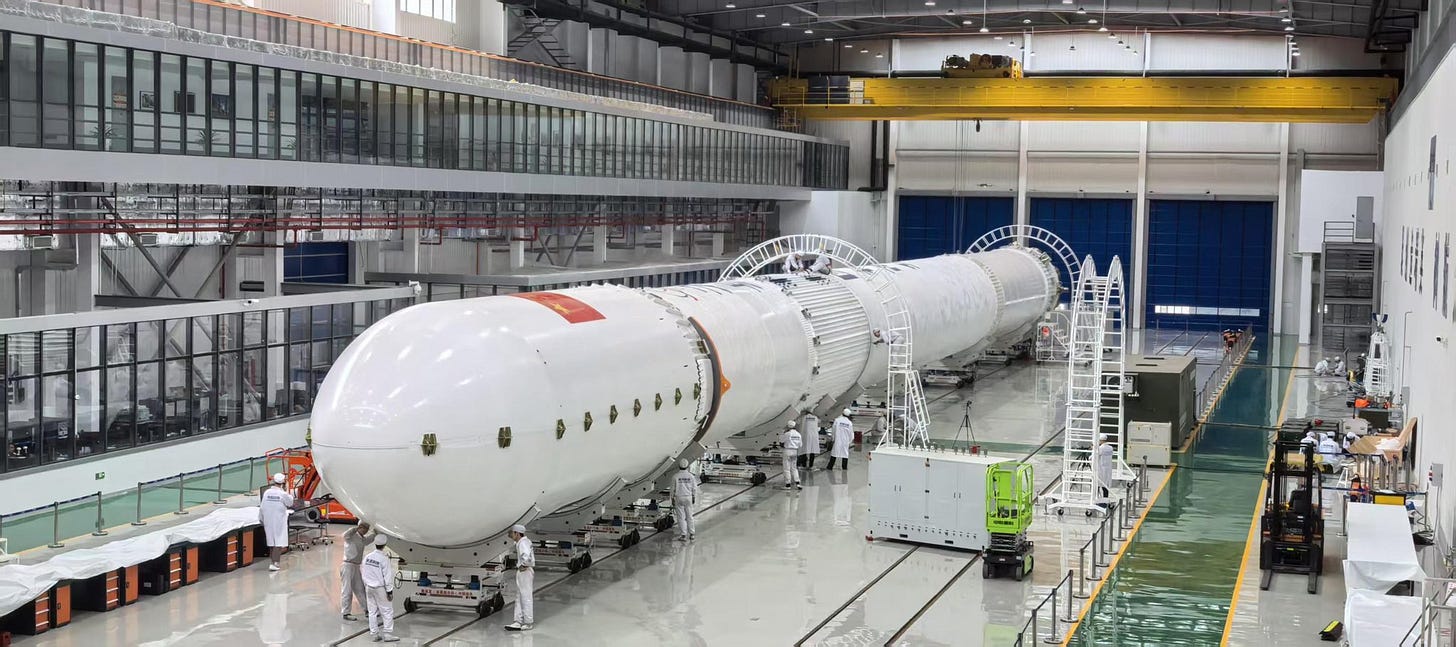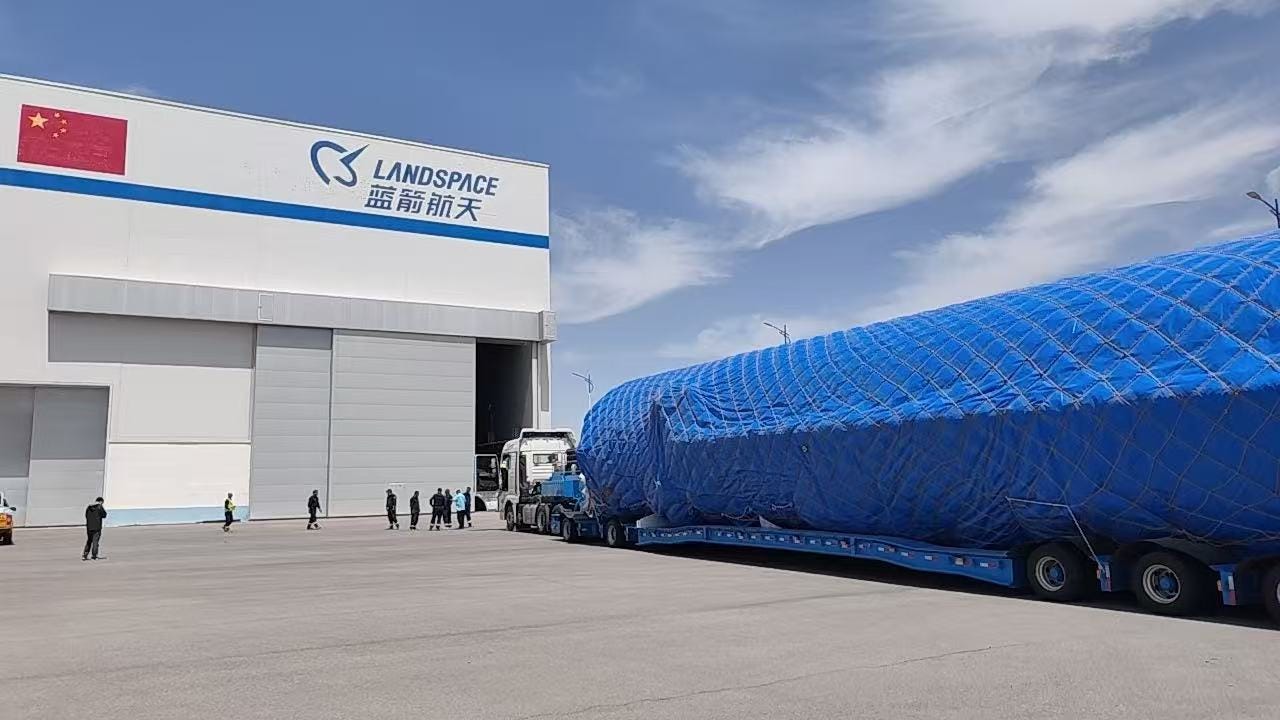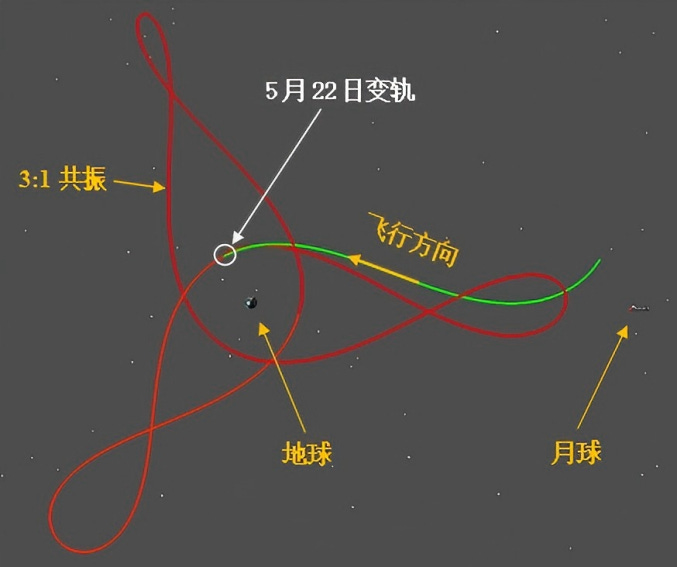Reusable Rockets Near Major Tests Ahead of Debut Launches
Meanwhile scientific satellites enter a complex orbit and begin operational observations.
With the Dragon Boat Festival (端午节) public holidays concluding, a flurry of continued activity across China’s space sector will occur in the next few weeks. But the last few days of May were quite busy, beginning with a message from the Shenzhou-20 crew, Chen Dong (陈冬), Chen Zhongrui (陈中瑞), Wang Jie (王杰), for International Childrens Day1.
Zhuque-3 arrives at Jiuquan
LandSpace quietly shared on June 1st a picture of Zhuque-3’s first-stage, covered in a massive protective blanket, arriving at the company’s launch vehicle processing building at the Jiuquan Satellite Launch Center. In late April, the rocket’s first-stage is believed to have departed LandSpace’s manufacturing facility in Jiaxing (嘉兴市), where it was fully outfitted for testing.
Now at Jiuquan, the first-stage is likely undergoing preparations for a static fire test on its launch pad, which has been ready since the beginning of the year. Zhuque-3’s transporter-erector has also been awaiting a first-stage for several weeks.
It is unknown when a static fire of Zhuque-3’s first-stage will occur, but it is rumored to be set for this month. Preparations for the rocket's debut flight may occur soon after depending on the outcome of the test.
LandSpace is hoping to fulfill an ambitious year with Zhuque-3 in 2025, targeting three flights and the landing of a first-stage, with Zhang Changwu (张昌武), Chief Executive Officer of the company, informing China Daily in February:
"These launches will deliver a combined payload capacity of around 60 tons, and we are targeting the successful recovery of the rocket's first stage within these three missions"
Details on the second-stage of Zhuque-3’s first flight vehicle are fewer, with engineers disclosing in April that it had completed assembly.
Tianlong-3 ready for pre-launch testing

China Central Television aired a short report on commercial space enterprises on May 28th, with Space Pioneer’s Tianlong-3 launch vehicle being one of the focuses. In the report, Vice President of the company Luo Yi (罗毅) stated that the first Tianlong-3 launch vehicle intended for controlled flight has completed assembly and hardware installations and is ready for testing.
A timeline for testing Tianlong-3 is currently unknown, but the first-stage is believed to be heading for Haiyang to be loaded onto a floating platform. That floating platform will then support a first-stage static fire, having been outfitted with the necessary hardware.
Tianlong-3’s first static fire test became quite well known in its aftermath, due to the test first-stage breaking free of the test stand before crashing into a mountainside around fifty seconds later. Thanks to pre-testing evacuations, only minor injuries were said to have been caused.
Where are photos of Tianwen-2?
The Tianwen-2 asteroid sample return mission successfully blasted off from Xichang, beginning a long journey out to asteroid 2016HO3/469219 Kamoʻoalewa, on May 28th. With the launch of the spacecraft, it had been expected by some that images of the spacecraft would be released, but, at the time of writing, none have.
It’s unknown why images of the completed Tianwen-2 haven’t been shared, but Weibo user Space Stack (空间栈) has a few theories that I think are worth consideration. Those theories are:
A deliberate strategy to spread out publicly released materials over the mission’s 10-year timeline. Holding back early content helps sustain public engagement later.
The lack of photos could indicate the use of classified or highly advanced technology. This would require secrecy even in a scientific mission, though there’s no direct evidence.
Tianwen-2 might be carrying a small, disposable camera to take a self-portrait later in the mission. If true, the photo release is simply delayed by design.
Alternatively, photos haven't been released due to the fear of mission failure. This theory is weak, as the mission has already received detailed and confident publicity.
Tiandu-1 enters complex Earth-Moon orbit
China’s Deep Space Exploration Laboratory (深空探测实验室) shared on May 25th that the Tiandu-1 satellite, performing communications experiments and technology verifications out near the Moon, has recently entered a 3:1 resonance orbit in Earth-Moon space. A 3:1 resonance orbit around the Earth-Moon system is an orbit where an object completes three revolutions around Earth in the same time the Moon completes one.
With the spacecraft in a 3:1 resonance orbit, the laboratory provided a small update on the spacecraft’s mission:
“The orbital maneuver marks Tiandu-1 as the first probe to enter the Earth-Moon round-trip 3:1 resonance orbit, and its flight data will provide important support for spacecraft orbit maintenance and control, autonomous navigation and other technical research in complex gravitational environments.” — “At present, a number of new technology tests in orbit have been completed, and the flight mission has been a complete success. In the follow-up expansion mission, Tiandu-1 will further verify the key technology of the construction of the Earth-Moon communication and remote integrated constellation system.”
If there are any problems with this translation please reach out and correct me.Astronstone completes 100-million funding round
Astronstone (宇石空间), also known as Beijing Uishi Space Technology Co Ltd (北京宇石空间航天科技有限公司), completed its first funding round back in March, having raised tens of millions of Yuan. Recently on May 29th, the company announced it had completed another funding round, this time raising over 100 million Yuan (approximately 13.9 million United States Dollars, as of June 2nd).
This latest funding round was led by Qiancheng Capital (千乘资本) with additional funding from Huacang Capital (华仓资本) and Lingge Venture Capital (麟阁创投), with Lingge contributing to both funding rounds now. Like the previous funding round, the capital raised is planned to support the development of the company’s two-stage partially reusable launch vehicle.
That launch vehicle, called AS-1, is expected to be made of stainless steel and burn liquid methane and liquid oxygen, with nine engines on the first-stage generating 700 tons of thrust, to allow Astronstone to develop a low-cost launch system, mainly to target launch contracts of various Chinese mega-constellations. Cost-wise, the company is aiming to have launch costs between 10,000 to 20,000 Yuan per kilogram of cargo, for launches costing between 100 million to 314 million Yuan.
This vehicle is currently planned to be 4.2 meters in diameter and 70 meters tall and weigh 570,000 kilograms fully fuelled. For payload, the company is aiming to have AS-1 deliver 15,700 kilograms into orbit when expended or 10,000 kilograms when reused. Reuse plans will see the booster caught by a catch tower.
Over the next few months, Astronstone plans to produce both stages of its rocket, followed by static fire tests, as well as testing a full-scale prototype of its catch towers systems. Like many newer Chinese launch startups, Astronstone has opted to externally source its rocket engines, buying a customised version of Jiuzhou Yunjian’s (九州云箭) liquid methane and liquid oxygen burning Longyun engine that will generate 80 tons of thrust. That engine notably supported its third reusable rocket test at the end of May.
Astronstone’s investors are confident in the company, with the three invested companies stating:
Qiancheng Capital: "The core pain points in China's commercial space sector lie in the high cost of high-thrust liquid rockets and the lack of commercial rocket companies capable of meeting the massive demand from two major satellite constellations. Adhering to three core investment principles: 'invest in liquid, not solid'; 'invest in large, not small'; and 'invest in reusable, not expendable'. We firmly believe in the technical potential of stainless steel structures, liquid oxygen-methane propulsion, and the 'chopstick recovery' method. These are, in our view, the optimal solutions for achieving ultra-low-cost access to space.”
“Compared to traditional 3.35-meter expendable rockets, 4-meter-class liquid rockets pose a series of significant technical challenges, such as the force transmission mechanisms in a 9-engine parallel configuration, trajectory and impact point control at the systems level, and the structural form of common bulkhead tanks. Addressing these challenges requires a company leader with exceptional strategic decision-making capabilities and deep understanding of both overall rocket design and propulsion systems.”
“Dr. Tang Wen, who has worked within the national system on CZ-5 and CZ-7, is one of the rare dual-discipline experts proficient in both liquid oxygen-methane propulsion and stainless steel structures. Qiancheng Capital is confident that under Dr. Tang’s leadership, Astronstone will achieve a breakthrough in launching China’s first stainless steel rocket from ground zero."
Huacang Capital: "We’ve been deeply engaged in the commercial aerospace industry for years, with investments spanning from upstream rocket structure supply chains to full satellite systems. The current bottleneck in China’s commercial space sector is the limited supply of rocket launches, and digging deeper, the real issue lies in the production capacity and cost disadvantages of traditional aluminum alloy propellant tanks.”
“Astronstone focuses on stainless steel liquid rockets and has a mature 30X-grade materials system. They replace traditional aluminum alloy rockets’ friction stir welding with a more efficient skin-stringer structure and argon arc welding, reducing costs by a factor of ten. At the same time, they are actively developing and deploying their unique 'chopstick recovery' technology for reusable rockets.”
“Astronstone possesses a complete, in-house stainless steel liquid rocket R&D team and has already achieved several breakthroughs in stainless steel structures from zero to one in the industry. We look forward to the successful maiden launch of their rocket in the near future."
Lingge Venture Capital: "Following its first round of financing, the Astronstone team rapidly completed both the rollout of the second-stage tank and the Angel+ round of funding, fully demonstrating the team’s outstanding technical depth, engineering capabilities, and execution power.”
“We are extremely excited and confident that the team will unleash even greater strength and brilliance in the future, becoming a pillar of China’s commercial space sector. Lingge Ventures will continue to support the company's growth, as a co-entrepreneur with scientists and a long-term partner to founders!"
If there are any problems with this translation please reach out and correct me.Longyun vacuum variant completes 400-second firing
Jiuzhou Yunjian (九州云箭) shared on May 28th that the vacuum optimized variant of its Longyun engine, which burns liquid methane and liquid oxygen to generate up to 80 tons of thrust, had completed a 400-second long test firing.
According to the company, this test verified the firing of the engine in a flight-duration profile along with its startup and shutdown sequence. Additionally, the test brings the total time of Longyun’s vacuum variant over 2,000 seconds.
Geely constellation to provide worldwide services
The Geely Future Mobility Constellation, backed by Chinese automaker Geely, is planning to launch an undisclosed number of satellites this year to begin providing worldwide services this year, with a short news brief stating:
“This year, Geely will conduct intensive launches to complete the networking deployment of the first phase of the constellation. Then, Geely will realize real-time satellite communication services covering the world.”
If there are any problems with this translation please reach out and correct me.Despite not stating the number of satellites planned to be launched, it is known that the first phase of the constellation will consist of 72 satellites, with 30 launched. Previous satellite batches have been launched on board the Long March 2C and Long March 6, possibly meaning four launches are needed to complete phase one.
Following phase one, there are plans to launch 264 more satellites to improve services and to include connectivity to mobile phones and satellite internet services, on top of the previously planned communication, connectivity, and positioning services. A third phase could add another 5,676 satellites to greatly improve services.
SVOM enters operational phase
The French National Centre for Scientific Research announced on May 21st that the Franco-Chinese SVOM gamma-ray burst detection mission, launched June 2024, is entering the operational phase, with the centre’s announcement stating:
“The verification phase of the French-Chinese space mission SVOM, devoted in particular to the detection and study of the most distant explosions or fusions of stars, the gamma-ray bursts, was completed with very promising initial results. The result of a collaboration between the two national space agencies, the China National Space Administration (CNSA) and the French National Centre for Space Studies (CNES), with the main contributions from the [Alternative Energies and Atomic Energy Commission] and the [National Centre for Scientific Research] for France, SVOM is now moving into the operational phase.”
Tianzhou-9 to launch in July
The China Space Foundation (中国航天基金会) released the science popularization notice for the Tianzhou-9 cargo resupply mission on May 28th, indicating that the mission will launch to the Tiangong Space Station in July. At present, the Tianzhou-9 mission is believed to be undergoing launch preparations.
Like previous Tianzhou missions, this cargo resupply mission is expected to launch atop of a Long March 7 from Launch Complex 201 at the Wenchang Space Launch Site.
International Children’s Day is observed worldwide on November 20th, but in current and former socialist countries it is observed on June 1st.




